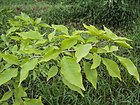Note: This is a project under development. The articles on this wiki are just being initiated and broadly incomplete. You can Help creating new pages.
Aegle marmelos - Bilva
Bilva consists of pulp of entire, unripe or half ripe fruits of Aegle marmelos Carr, It is a tree, attaining a height of 12 m growing wild and also cultivated throughout the country, rind of fruit is removed and pulp is bruised and dried.[1]
Uses
Fever, Nasal bleeding, Diarrhoea, Skin disease, Intestinal worms, Cough, Diabetes, Vomiting, Cough, Stomachache, Infection in intestine.[2]
Food
Bilva can be used in food. Ripe fruit pulp is eaten raw and also used for making soft drinks and jam[3]
Parts Used
Chemical Composition
A number of coumarins (including xanthotoxol and alloimperatorin methyl ether), flavonoids (including rutin and marmesin), alkaloids (including alpha-fagarine), sterols and essential oils have been isolated from plant parts. Pectin is an important constituent of the fruit. [4]
Common names
| Language | Common name |
|---|---|
| Kannada | Bilva patre |
| Hindi | Bela, Sriphal |
| Malayalam | Koovalam |
| Tamil | Vilvam |
| Telugu | Maredu |
| Marathi | Bel, Baela |
| Gujarathi | Bill, Bilum, Bilvaphal |
| Punjabi | Bil |
| Kashmiri | Bel |
| Sanskrit | Shreephala |
| English | Bengal Quince, Bael fruit |
Properties
Reference: Dravya - Substance, Rasa - Taste, Guna - Qualities, Veerya - Potency, Vipaka - Post-digesion effect, Karma - Pharmacological activity, Prabhava - Therepeutics.
Dravya
Rasa
Katu (Pungent), Tikta, Kashaya
Guna
Laghu (Light), Ruksha (Dry)
Veerya
Ushna (heat)
Vipaka
Katu (Pungent)
Karma
Balya, Deepana, Grahya, Paacana
Prabhava
Nutritional components
Bilva contains the Following nutritional components like Thiamine, Ribofl avin, Vitamin - C, Niacin; Calcium, Phosphorus, Potassium, Sodium Zinc[3]
Habit
Identification
Leaf
| Kind | Shape | Feature |
|---|---|---|
| Alternate | Trifoliate | Each leaflet 5-14 x 2–6 cm, ovate with tapering or pointed tip and rounded base, untoothed or with shallow rounded teeth. Young leaves are pale green or pinkish |
Flower
| Type | Size | Color and composition | Stamen | More information |
|---|---|---|---|---|
| Bisexual | 1.5 to 2 cm | Pale green or yellowish | The four or five petals of 6–8 mm overlap in the bud and The ovary is bright green with an inconspicuous disc, Flowering season: March-June |
Fruit
| Type | Size | Mass | Appearance | Seeds | More information |
|---|---|---|---|---|---|
| Globose or slightly pear-shaped | The bael fruit typically has a diameter of between 5 and 12 cm | Many | Fruiting on March-June |
Other features
List of Ayurvedic medicine in which the herb is used
Where to get the saplings
Mode of Propagation
Cultivation Details
Development of seedlings is very slow, and need to be in the nursery for at least a year[6]. Bilva's availability period is from March to June[3]
Commonly seen growing in areas
Photo Gallery
References
- ↑ THE AYURVEDIC PHARMACOPOEIA OF INDIA, PART-I, VOLUME-1, page no 35.
- ↑ Karnataka Aushadhiya Sasyagalu By Dr.Maagadi R Gurudeva, Page no:239
- ↑ 3.0 3.1 3.2 3.3 "Forest food for Northern region of Western Ghats" by Dr. Mandar N. Datar and Dr. Anuradha S. Upadhye, Page No.18, Published by Maharashtra Association for the Cultivation of Science (MACS) Agharkar Research Institute, Gopal Ganesh Agarkar Road, Pune
- ↑ Constituents
- ↑ Morphology
- ↑ Cultivation details
External Links
- Ayurvedic Herbs known to be helpful to treat Fever
- Ayurvedic Herbs known to be helpful to treat Nasal bleeding
- Ayurvedic Herbs known to be helpful to treat Diarrhoea
- Ayurvedic Herbs known to be helpful to treat Skin disease
- Ayurvedic Herbs known to be helpful to treat Intestinal worms
- Ayurvedic Herbs known to be helpful to treat Cough
- Ayurvedic Herbs known to be helpful to treat Diabetes
- Ayurvedic Herbs known to be helpful to treat Vomiting
- Ayurvedic Herbs known to be helpful to treat Stomachache
- Ayurvedic Herbs known to be helpful to treat Infection in intestine
- Herbs with Seeds used in medicine
- Herbs with Leaves used in medicine
- Herbs with common name in Kannada
- Herbs with common name in Hindi
- Herbs with common name in Malayalam
- Herbs with common name in Tamil
- Herbs with common name in Telugu
- Herbs with common name in Marathi
- Herbs with common name in Gujarathi
- Herbs with common name in Punjabi
- Herbs with common name in Kashmiri
- Herbs with common name in Sanskrit
- Herbs with common name in English
- Habit - Tree
- Index of Plants which can be propagated by Seeds
- Herbs that are commonly seen in the region of Tropical area
- Herbs that are commonly seen in the region of Temperate area
- Herbs
- Rutaceae
- Ayurvedic herbs that don't have seed photos




